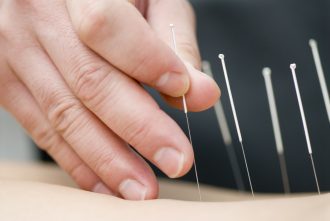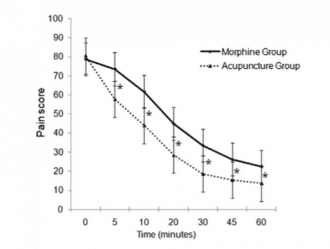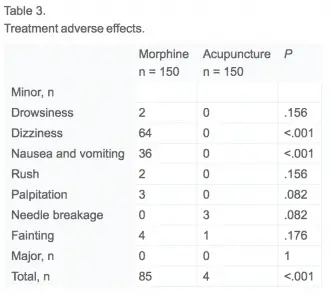By Sayer Ji
Contributing writer for Wake Up World
An amazing study has found that acupuncture, the ancient practice of using needles to stimulate self-healing in the body, is more effective than intravenous morphine for acute pain relief.
A truly groundbreaking study published in the American Journal of Emergency Medicine, titled “Acupuncture vs intravenous morphine in the management of acute pain in the ED”, reveals that acupuncture — one of the oldest techniques to treat pain — is more effective, faster in relieving pain, and with less adverse effects, than intravenous morphine.
The study[1] was conducted over the course of a 1-year period at the Fattouma Bourguiba University Hospital in Tunisia, a tertiary care facility with over 100,000 Emergency Department (ED) visits per year.
300 ED patients with acute pain were included in the study: 150 in the morphine group (administered up to 15 mg a day) and 150 in the acupuncture group. The two groups were comparable in terms of age, sex, and co-morbidities, with the only significant difference being that there were more abdominal pain patients in the morphine group and more low back pain cases in the acupuncture group.
The striking results were reported as follows:
“Success rate was significantly different between the 2 groups (92% in the acupuncture group vs 78% in the morphine group P b .01). Resolution time was 16 ± 8 minutes in the acupuncture group vs 28 ± 14 minutes in the morphine group. The difference was statistically significant (P b .01). The mean absolute difference in pain score between the 2 groups was 7.7. This difference is not clinically significant because the minimal clinically significant absolute difference reported by Todd et al is 13. In morphine group, the mean total dose of morphine administered was 0.17 ± 0.08 mg/Kg (Table 2).
“The pain scale change from baseline at each time point in the 2 groups is shown in Figure. From the 5-minute time point, the acupuncture group reported significantly larger pain decrease compared with the morphine group. This difference persisted during the entire study period. Change of blood pressure, HR, RR, and oxygen saturation was not significant in both groups.
“Overall, 89 patients (29.3%) experienced minor adverse effects: 85(56.6%) in morphine group and 4 (2.6%) in acupuncture group; the difference was significant between the 2 groups (Table 3). The most frequent adverse effect was dizziness in the morphine group (42%) and needle breakage in the acupuncture group (2%). No major adverse effect was recorded during the study protocol. (See Table.)”
In short, the acupuncture group saw a great pain-relieving effect, which occurred faster, with significantly less side effects.
Discussion
Since 1996, the World Health Organization has recognized acupuncture as a safe and effective therapy for the treatment of a wide range of conditions, including pain and discomfort.[2] Despite this, the use of acupuncture within the conventional standard of care is still exceedingly rare. A deep skepticism exists for therapeutic modalities that do yet have a clearly characterized mechanism of action, as defined through conventional biomedical understanding and terminology. Often, in lieu of this, its therapeutic effects are written off as merely “placebo”.
Placebo, however, is not as diminutive term as it may first seem. The placebo effect actually reflects the deep power and regenerative capability of the body-mind to heal itself. And since its power translates directly into real, measurable improvements in terms of clinical outcomes, it does not matter if we fully understand “how” it works. Also, consider that “evidence-based” (EB) medicine not only depends entirely on clinical outcomes as final proof of an intervention’s efficacy, but also, the entire EB medicine model depends on “controlling” for the placebo effect, as it is already tacitly recognized as having immense power in influencing the outcomes in most interventions. And so, whether or not a fully known or plausible “mechanism of action” has been identified is secondary in importance to whether it works or not in clinical practice.
Acupuncture happens to be one of the most extensively supported alternative modalities, with clinical trial data supporting its value in over 100 different conditions. If you do a pubmed.gov search you’ll find over 6,700 published studies related to the keywords “pain” and “acupuncture.” You can view the primary literature we have gathered on the topic at the Acupuncture page on GreenMedInfo.com.
Clearly the new study reveals that acupuncture has a powerful role to play in pain management. With addiction to pain relieving drugs affecting millions around the world, acupuncture is perfectly poised to provide patients a time-tested, drug-free alternative. As you can see from the study’s graph (table 3), the adverse effects comparison is staggeringly in favor of acupuncture as the safer modality.
Finally, here are the study’s powerful conclusions:
“Our study demonstrated that in patients with acute pain syndromes presenting to the ED, acupuncture is at least as efficacious and has a better safety profile than IV morphine. The results of this study suggest that acupuncture has a potential role in controlling acute pain conditions presenting to EDs and appears to be safe and effective. Future studies should be performed in international populations.”
For additional research on natural pain relief options visit the Pain Database on GreenMedInfo.com.
References:
- [1] American Journal of Emergency Medicine. Acupuncture vs intravenous morphine in the management of acute pain in the ED, 2016
- [2] World Health Organization. Acupuncture: review and analysis of reports on controlled clinical trials, 2002
Recommended articles by Sayer Ji:
- Brain Regeneration: Why It’s Real and How To Do It
- Research: Garlic is an Effective Natural Treatment for Heart Disease
- Wi-Fi Devices Increase Mercury Release From Dental Amalgams
- “Killer Germs” Obliterated by Medicinal Smoke Smudging, Study Reveals
- Turmeric’s ‘Smart Kill’ Properties Put Chemo & Radiation To Shame
- Beet Juice Boosts Cognitive Function In One Dose
- The Amazing Healing Properties of Apples
- 6 Bodily Tissues That Can Be Regenerated Through Nutrition
- How Turmeric Can Save the Aging Brain From Dementia and Premature Death
- Eating Wheat Feeds Disease-Causing Gut Bacteria, Study Suggests
- Toxic Algae: Causes of Florida’s Environmental Disaster Denied by Media and Authorities
About the author:
Sayer Ji is the founder of Greenmedinfo.com, a reviewer at the International Journal of Human Nutrition and Functional Medicine, Co-founder and CEO of Systome Biomed, Vice Chairman of the Board of the National Health Federation, and Steering Committee Member of the Global Non-GMO Foundation.
For more, visit GreenMedInfo.com and Facebook.com/GreenMedInfo, or sign up for GreenMedInfo’s free e-Newsletter.
© August 6th, 2016 GreenMedInfo LLC. This work is reproduced and distributed with the permission of GreenMedInfo LLC. Want to learn more from GreenMedInfo? Sign up for their newsletter here.

If you've found value in our articles, we invite you to support the release of our brand-new book, "Gratitude Practices for Kids: A Practical Guide for Adults to Instill a Spirit of Appreciation and Positivity in the Next Generation."
"Gratitude Practices for Kids" brings together over 25 innovative and accessible practices designed to enhance gratitude in everyday life. This comprehensive guide is backed by 17 scientific studies, ensuring each concept is grounded in research, underscoring our commitment to nurturing growth, emotional intelligence, and positive interactions between adults and children.
We encourage you to opt for the paperback version to celebrate this new release. Dive into its fresh pages away from digital distractions, allowing you to immerse yourself in the transformative practices it offers.
Over recent years, Wake Up World has faced significant online censorship, which has impacted our financial ability to operate. Moving into book publishing represents a strategic step to secure the ongoing funds needed to continue our mission. By purchasing Gratitude for Kids, you help us keep our content free and accessible to everyone, avoiding needing a paywall. With over 8,500 articles published in the last 13 years, we remain dedicated to keeping our valuable content open to all.











